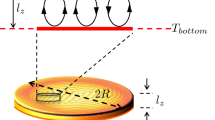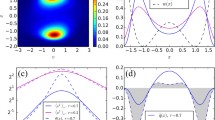Abstract
A system of slow convective thermals is considered in a vicinity of convection level. It is shown that a system of spherical convective thermals of fixed radius can be described by a stochastic equation, which is practically identical to Langevin equation for an ensemble of classical Brownian particles. Under the proposed approach, it was shown that the mean vertical velocity of a system of thermals at the convection level is zero. A kinetic analogue of thermodynamic temperature, corresponding to the second moment of the vertical velocity, was shown to exist for a system of thermals. Moreover, the associated Fokker–Planck equation for the system of slow convective thermals has a stationary solution corresponding to generalized Maxwell distribution over vertical velocities. Numerical and field experiments convincingly show that the generalized Maxwell equations is in agreement with the results of calculations and atmospheric measurements.






Similar content being viewed by others
REFERENCES
Vul’fson, A.N., Equations of deep convection in dry atmosphere, Izv. Akad. Nauk SSSR, Fiz. Atmos. Okeana, 1981, vol. 17, no. 8, pp. 873–876.
Vul’fson, A.N. and Borodin, O.O., Ensemble of convective thermals as generalized analysis of Brownian particles, Usp. Fiz. Nauk, 2016, vol. 162, no. 2, pp. 113–124.
Vul’fson, A.N. and Borodin, O.O., On the stability of Maxwell distribution for a system of thermals in turbulent convective layers of fresh and salt water bodies, Water Resour., 2016, vol. 43, no. 1, pp. 66–72.
Vul’fson, A.N. and Borodin, O.O., The Fokker–Planck equation and statistical characteristics of penetrative convection in the upper ocean, Dokl. Earth Sci., 2011, vol. 440, no. 1, pp. 1287–1290.
Klimontovich, Yu.L., Statisticheskaya teoriya otkrytykh sistem (Statistical Theory of Open Systems), Moscow: Yanus, 1995.
Caughey, S.J., Kitchen, M., and Leighton, J.R., Turbulence structure in convective boundary layers and implications for diffusion, Boundary-Layer Meteor., 1983, vol. 25, no. 4, pp. 345–352.
Caughey, S.J. and Palmer, S.G., Some aspects of turbulence structure through the depth of the convective boundary layer, Quart. J. R. Meteorol. Soc., 1979, vol. 105, pp. 811–827.
Deardorff, J.W., Convective velocity and temperature scales for the unstable planetary boundary layer and for Rayleigh convection, J. Atmos. Sci., 1970, vol. 27, no. 8, pp. 1211–1212.
Deardorff, J.W. and Willis, G.E., Further results from a laboratory model of the convective planetary boundary layer, Bound.-Layer Meteor., 1985, vol. 32, pp. 205–236.
Du, S., Wilson, J.D., and Yee, E., On moments approximation method for constructing a Lagrangian stochastic model, Bound.-Layer Meteorol., 1993, vol. 63, pp. 65–96, 1994, vol. 40, pp. 2739–292.
Fedorovich, E., Nieuwstadt, F.T.M., and Kaiser, R., Transition regimes and development of the mixed layer, Pt. I, J. Atmos. Sci., 2001, vol. 58, pp. 70–86.
Hibberd, M.F. and Sawford, B.L., A saline laboratory model of the planetary convective boundary layer, Bound.-Layer Meteorol., 1993, vol. 63, pp. 65–96., 1994, vol. 67, pp. 229–250.
Huppert, H.E. and Turner, J.S., Double-diffusive convection, J. Fluid Mech., 1981, vol. 106, pp. 299–329.
Lamb, R.G., Diffusion in the convective boundary layer, Atmospheric Turbulence and Air Modelling, Nieuwstadt, F.T.M., and H. van Dop, D., Boston: Reidel Publication Company, 1982, pp. 159–229.
Lenschow, D.H. and Stephens, P.L., The role of thermals in the convective boundary layer, Bound.-Layer Meteor., 1980, vol. 19, no. 4, pp. 509–532.
Lenschow, D.H., Wyngaard, J.C., and Pennell, W.T., Mean field and second-moment budgets in a baroclinic, convective boundary layer, J. Atmos. Sci., 1980, vol. 37, no. 6, pp. 1313–1326.
Levine, J., Spherical vortex theory of bubble-like motion cumulus clouds, J. Meteor., 1959, vol. 16, no. 6, pp. 653–662.
Luhar, A.K. and Britter, R.E., A random walk model for dispersion in inhomogeneous turbulence in a convective boundary layer, Atm. Environ., 1989, vol. 23, pp. 1911–1924.
Ogura, Y. and Phillips, N.A., Scale analysis of deep and shallow convection in the atmosphere, J. Atmos. Sci., vol. 32, no. 2, pp. 173–179.
Pope, S.B., Turbulent Flows, Cambridge: Cambridge Univ. Press, 2000.
Priestly, C.H.B., Turbulent Transfer in the Lower Atmosphere, Chicago: Univ. Chicago Press, 1959.
Schmidt, H. and Schumann, U., Coherent structure of the convective boundary layer derived from large-eddy simulations, J. Fluid Mech., 1989, vol. 200, pp. 511–562.
Scorer, R.S. and Ludlam, F.H., Bubble theory of penetrative convection, Quart. J. R. Meteorol. Soc., 1953, vol. 79, pp. 94–106.
Shin, H.H., Hong, S.-Y., and Noh Y., Derivation of turbulent kinetic energy from a first-order nonlocal planetary boundary layer parameterization, J. Atmos. Sci., 2013, vol. 70, pp. 1795–1805.
Sparow, E.M., Husar, R.B., and Goldstein, R.J., Observation and other characteristics of thermals, J. Fluid Mech., 1970, vol. 41, no. 4, pp. 793–800.
Turner, J.S., Buoyancy Effects in Fluids, Cambridge: Cambridge Univ. Press, 1979.
Van Kampen, N.G., Stochastic Processes in Physics and Chemistry, Amsterdam: North Holland: Elsevier, 2007.
Vulfson, A.N. and Borodin, O.O., Brownian ensemble of random-radius buoyancy vortices and Maxwell velocity distribution in a turbulent convective mixed-layer, Phys. Fluids, 2018, vol. 30. 095103. https://doi.org/10.1063/1.5042676
Vul’fson, A.N. and Borodin, O.O., Maxwell velocity distribution for a stochastic ensemble of thermals in a turbulent convective mixed-layer, Kinet. Appr. Procedia IUTAM, 2013, vol. 8, pp. 238–247.
Willis, G.E. and Deardorff, J.W., A laboratory model of the unstable planetary boundary layer, J. Atmos. Sci., 1974, vol. 31, pp. 1297–1307.
Funding
This study was carried out under research project 0147-2019-0001, state registration АААА-А18-118022090056-0).
Author information
Authors and Affiliations
Corresponding authors
Additional information
Translated by G.Krichevets
Rights and permissions
About this article
Cite this article
Vul’fson, A.N., Borodin, O.O. & Demin, D.O. An Ensemble of Brownian Particles and a Stochastic Description of a System of “Slow” Convective Thermals at Convection Level. Water Resour 49, 212–222 (2022). https://doi.org/10.1134/S0097807822020130
Received:
Revised:
Accepted:
Published:
Issue Date:
DOI: https://doi.org/10.1134/S0097807822020130




